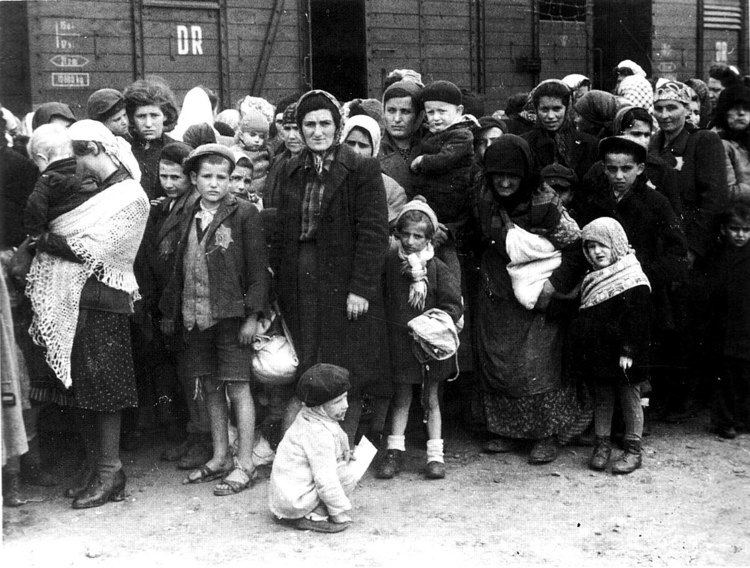 | ||
Prior to the deporation of individuals of Jewish background to the concentration camps there were at least 2,173 Jews in Norway. During the Nazi occupation of Norway 772 of these were arrested, detained, and/or deported, most of them sent to Auschwitz. 742 were murdered in the camps, 23 died as a result of extrajudicial execution, murder, and suicide during the war. Between 28 and 34 of those deported survived their continued imprisonment (following their deportation). The Norwegian police and German authorities kept records of these victims, and so, researchers were able to compile information about the deportees.
Contents
Before deportation
The deportation followed a series of steps to discriminate, persecute, and disenfranchise Jews in Norway. Jewish individuals were at first arrested, Jewish property was confiscated, Jews were ordered to report to local police stations and have their identification cards stamped with a "J" and fill in a lengthy form about their profession, holdings, and family. Based on the lists the police compiled, most Jewish adult men were arrested and detained in October 1942, and by November 26, women and children were also arrested for deportation. This is the only time in Norwegian history that Norwegian police had been ordered to arrest children.
The deportation from Norway to concentration camps followed a planned staging of events involving both Norwegian police authorities and German Gestapo, Sicherheitsdienst, and SS staff, though the front for the campaign was through Statspolitiet under the command of Karl Marthinsen:
Detentions and deportation took on scale when all Jewish men were ordered arrested on October 26, 1942 and sent to camps in Norway, notable Berg, Grini, and Falstad, where they were held under harsh conditions until the deportation, targeted for November 26 on the Donau.
Women and children were arrested on or just before November 26 with the goal of deporting them the same day.
The arrests were conducted by Norwegian policemen and lensmenn—not by Germans—according to Baard Herman Borge (a researcher).
After arrival at the pier in Oslo
Deportation
The deportation schedule for the major transports was:
Most of those deported were Norwegian citizens. Some were stateless refugees, and a few were citizens of other countries.
In addition to those Jews from Norway which were killed by the Nazis in death camps (Vernichtungslager), at least 22 more Jews died in Norway as a result of murder, extrajudicial executions and suicide.
Distribution of deportees by county arrested and transport
Jewish individuals who were deported included those with Norwegian citizenship, foreign citizens, and stateless refugees that were arrested and deported. The site where they were arrested was not always their place of residence; many had relocated to rural areas to avoid detection. The majority of those deported were immediately murdered in the gas chambers at Auschwitz; some were put to slave labor but perished soon after. A very small number ultimately survived.
Notable Jews who died in prison camp
Liberation and return
Thousands of Norwegians were deported to camps in Germany and German-occupied territories during World War II. Most of those who survived were rescued by the White Buses campaign undertaken by the Norwegian government in exile, the Swedish government, the Danish government, with the Swedish Red Cross implementing the rescue with its offices. This followed intensive efforts by Norwegian and other Scandinavians to track and maintain contact with Norwegian citizens in camps.
By comparison, there was no organized effort to maintain contact with and establish the fate of Jews that had been deported from Norway.
Of the 34 who survived, at least 21 returned to Norway soon after the war.
The survivors were liberated from the following camps:
2015 saw the death of the last remaining survivor of those deported from Norway—Samuel Steinmann.
Aided by the organization behind the White Buses
Four Norwegian Jews were rescued by the White Buses. At least one prisoner at Dachau was denied—by an SS-soldier—leaving with the White Buses, because the prisoner allegedly was not considered a Norwegian since he was a Jew.
Reactions
In trials in 1946 and 1948 regarding Knut Rød's role in the deportations, he was found not guilty. An Aftenposten article in 2014 said that the not guilty verdict has been called "the point of absolute zero in Norway's judicial history".
Legacy
Individual deportees have been commemorated with stolpersteine on a number of sidewalks in Oslo.
Notable survivors
Literature
Stefansen, Arnt; Feinberg, Kai (1995). Fange nr 79108 vender tilbake [Prisoner no. 79108 returns]. Cappelen.
